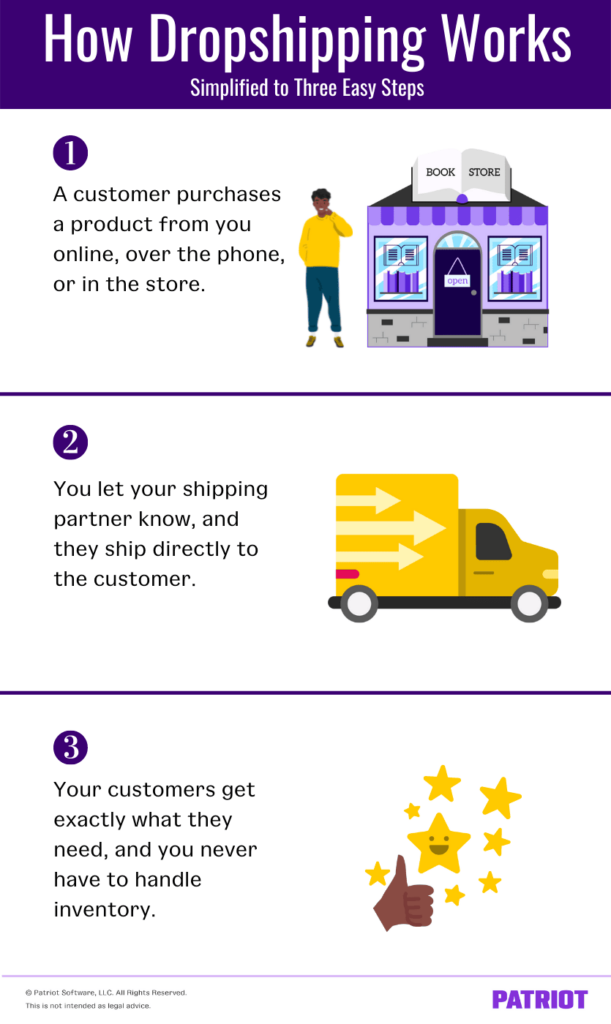Starting a business comes with obstacles that may seem insurmountable. You have to get a storefront, buy and store inventory, and sell and ship that inventory if needed. But, you don’t have to stick to the old ways of doing business if you don’t want to. With a dropshipping business, you can bypass a lot of the old obstacles. So, what is dropshipping?
Dropshipping is an order fulfillment method that allows you to outsource your inventory and shipping to another company. As a dropshipper, you can reduce some of the worries of running your business, automate certain tasks, and relax (a bit!).
Read on to learn more about dropshipping business and how to dropship.
What is dropshipping?
Dropshipping allows you to fulfill customer orders without ever having to deal with the product. Essentially, it is both a way to manage supply chains and curate your products. Instead of a retail space that also serves as a place to store inventory, your retail presence (on or offline) works to connect customers with the inventory a manufacturer or wholesaler holds.
It works like this:
- The customer places an order with your business.
- You charge the customer for their purchase.
- An order is automatically sent to your shipping partner (manufacturer or supplier) who ships the product.
- The shipping partner charges you for the shipment.
When setting up a dropshipping business, the name of the game is a short supply chain. The shorter the supply chain, the less money you’ll have to hand out to third parties. If possible, try to work directly with the manufacturer as often as possible.

How does dropshipping work?
Like any new business venture, you should do some research before you jump in. So, how does dropshipping work? Dropshipping requires many of the same things that a traditional inventory model does (e.g., market research, marketing campaigns, competitive pricing, etc.).
Before you get started, here are some things to put on (and check off) your to-do list:
- Find your market niche. You can only sell a product if there is enough demand. Programs like Google Keyword Planner and Facebook Audience Insights can help you figure out if there is any interest in your product. If the numbers are high, demand is already there. If the numbers are low, you may have an uphill battle ahead of you.
- Understand your market through analytics. Location is everything. If you are looking to break into new markets, dropshipping may be the right choice. Through a little bit of research, you can sell specific items in targeted areas. Google trends can give you insight into search results in specific parts of the country. With a little digging, you may realize that certain geographical markets are closer to suppliers or manufacturers than other places. Targeting areas with short supply lines can help you corner a market and provide quality service for your customers.
- Choose the right supplier (manufacturer or wholesaler). When choosing a supplier, make sure that your margin is profitable enough. Your supplier should give you tracking numbers for each order and allow for returns and refunds. If they can’t offer you either of these things, you may want to keep looking.
- Build your storefront online. You still have to worry about how you merchandise online. Dropshipping is a competitive business model, so make sure to put your best foot forward with your customers. You may want to think about testing the products yourself and personalizing the product descriptions.
- Analyze how your business is doing and make adjustments as needed. Like always, knowledge is power. Keep track of your sales and customer responses or customer satisfaction scores (CSAT scores). If your customers are unhappy with the product, listen to them. You can use CSAT scores or user-generated content to take the pulse of your customers and work to meet their needs.
Dropshipping comes with difficulties. While you deal with your product indirectly, you will deal with your customers directly. The quickest way to ruin your dropshipping business is to have terrible customer service. Your ability to deal with customer complaints is just as important as having the right product and supply line.
Pros and cons of dropshipping
Dropshipping may be exactly the type of business model you’re looking for. But, that doesn’t mean it’s going to be smooth sailing. Here are some of the things you’ll have to consider before jumping into the world of dropshipping.
Pros of dropshipping
Here are some of the benefits of dropshipping over traditional inventory models:
- Low overhead. Because you don’t have to purchase or house inventory, overhead costs are low. You also don’t have to worry about over-purchasing a product you never sell.
- Flexible location. If your dropshipping business is entirely online, geography won’t affect the way your business operates. As long as you have an internet connection and can contact your customers and suppliers with ease, your dropshipping business should run smoothly no matter where you are.
- Wide selection of products to sell. Without a warehouse to worry about, you can (theoretically at least) offer as many products as you want. But, try not to go overboard. An online storefront with no rhyme or reason can deter would-be customers.
- Protection from over-purchasing products and poor inventory management. Mistakes like over-purchasing or poor inventory management can’t happen with dropshipping. Because you don’t manage an inventory, you’ll never be stuck with inventory you don’t know how to get rid of.
- Easier to test product traction. Testing new products is low risk. If you try out a product and customers aren’t interested, you simply stop offering the product. Also, if customers are buying your product but aren’t happy with it for some reason, you can always look for a new manufacturer that offers a similar, but better, product.
Cons of dropshipping
Here are some of the difficulties of dropshipping over traditional inventory models:
- Small profit margins. Sure, overhead is low, but your margins can be even lower. Long supply chains and a highly competitive market can keep your margins razor-thin.
- Inventory issues. You aren’t the only one working with a wholesaler or manufacturer. There’s a chance that a product you sold is on order or backorder. If that’s the case, your customer will be waiting longer than either of you planned.
- Shipping and supplier problems. If you work with a large number of suppliers, you may run into problems with differences in inventory availability, shipping speeds, and billing methods. Think of it this way: If a customer orders four items coming from four different suppliers, there are going to be four different bills, shipping costs, methods, and tracking numbers for them to deal with. You might have to deal with these problems too if things go wrong. This can quickly become a headache for everybody.
- Lack of control over customer experience. Because you aren’t packing and shipping the products yourself, you place a lot of faith in your supplier or manufacturer. You won’t know if they’ve done a good job or not until a customer complains. Products could be damaged, incorrect, late, or misplaced—and you’ll have to handle the upset customer.
- Highly competitive. Bigger sellers have some advantages. They can reduce their markups to lower the price of their products, and they can draw up exclusive deals with their suppliers. The highly competitive nature of dropshipping means that you have to do great market research before you decide what you are going to offer your customers. And even then, you’ll still have to fit hard for your customer’s attention.
Looking for a better way to handle your accounting needs? Sign up for Patriot Software today to get a free trial of our accounting software. We’ve designed our software with our customers in mind (you’ll see what we mean when you give us a try!).
This is not intended as legal advice; for more information, please click here.
